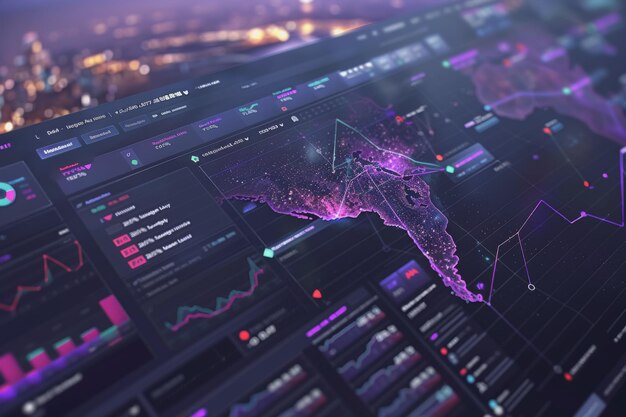Are you drowning in data and unsure how to navigate the complexities of analysis?
Python’s powerful Pandas library holds the key to effective data manipulation, offering an arsenal of techniques that can transform raw data into actionable insights.
In this article, we’ll explore essential data manipulation techniques using Pandas, discussing its core functionalities and the critical role of data cleaning in the analytical process. Prepare to unlock the full potential of your datasets and elevate your analytical skills!
Python Data Manipulation with Pandas
Data manipulation in Python is primarily conducted using the Pandas library, a powerful tool for data analysis and manipulation tasks.
Pandas provides essential data structures such as Series and DataFrames, enabling efficient handling of structured data.
Key functionalities of the Pandas library include:
-
Filtering Data: Users can easily filter datasets to isolate specific rows based on conditions, allowing focused analysis.
-
Handling Missing Values: Pandas offers various data cleaning techniques, such as filling or dropping NaN values, ensuring data integrity.
-
Merging and Joining Datasets: This functionality allows users to combine multiple datasets into a single DataFrame, accommodating a wide array of data sources.
-
Grouping Data for Aggregation: Users can group data by specific columns and apply aggregation functions, streamlining data analysis.
The library’s versatility extends to reading and writing data from different formats, such as CSV, Excel, and SQL databases, which enhances usability for data manipulation tasks.
The significance of data cleaning and preparation cannot be overstated; it lays the groundwork for effective data analysis.
Properly cleaned data contributes to accurate model predictions and overall analytical insights.
Pandas not only facilitates these processes but also supports various data manipulation techniques required in real-world scenarios.
The rich set of functionalities within the Pandas library empowers data scientists and analysts to perform sophisticated operations with relative ease, making it a cornerstone in the field of Python data manipulation.
Data Analysis Techniques for Python Data Manipulation
Data analysis with Python involves various techniques that enable users to extract meaningful insights from their datasets.
One critical approach is exploratory data analysis, which focuses on summarizing and visualizing datasets. This allows users to gain a clear understanding of the data’s structure, distribution, and relationships. Techniques such as histograms, scatter plots, and box plots are commonly employed in exploratory data analysis, facilitating the identification of patterns, trends, and potential outliers.
Statistical analysis in Python can be effectively conducted using the Pandas library, which offers the .describe() method. This method provides key statistics that summarize the central tendencies and variability of numerical data, including count, mean, standard deviation, and quartile distributions. These statistics are invaluable for understanding the underlying characteristics of the dataset.
Data aggregation techniques are essential for summarizing data based on specific criteria, enabling users to derive insights from grouped data. Functions like .groupby() in Pandas allow users to segment the dataset into various categories, applying aggregation functions such as sum, mean, or count to each group. This capability is particularly powerful for analyzing large datasets, revealing insights that may not be apparent at a glance.
In summary, the combination of exploratory data analysis, statistical analysis, and aggregation techniques provides a robust framework for conducting data analysis with Python, enabling users to effectively manipulate and gain insights from their data.
Techniki czyszczenia danych w Pythonie
Czyszczenie danych jest kluczowym krokiem w przygotowywaniu zbiorów danych do zadań związanych z uczeniem maszynowym.
Dane często zawierają nieścisłości, takie jak wartości NaN, Null czy NA.
Oto kilka istotnych technik czyszczenia danych w Pythonie:
-
Usuwanie specyficznych wierszy lub kolumn: Używając metody
.drop(), można łatwo usunąć niepotrzebne wiersze lub kolumny z DataFrame. -
Wypełnianie brakujących wartości: Metody takie jak
.fillna()pozwalają na uzupełnienie brakujących danych z wartościami stałymi, średnią, medianą lub innymi obliczeniami statystycznymi. -
Zamiiana typów danych: Przekształcanie typów danych za pomocą
.astype()jest istotne, by zapewnić, że kolumny mają odpowiednie typy, co umożliwia poprawne analizy. -
Usuwanie duplikatów: Funkcja
.drop_duplicates()pozwala na eliminację powtarzających się wierszy, co poprawia jakość zbioru danych. -
Normalizacja wartości: Przy pomocy
.apply()można transformować dane tak, aby były w jednorodnym formacie np. poprzez konwersję do małych liter lub usunięcie zbędnych spacji.
Zastosowanie tych technik w Pythonie, szczególnie przy użyciu biblioteki Pandas, znacznie upraszcza proces czyszczenia i przetwarzania danych.
Umożliwia to nie tylko uzyskanie wyższej jakości danych, ale także poprawia dokładność modeli uczenia maszynowego.
Data Transformation and Visualization in Python
Data transformation in Python is a fundamental step in preparing datasets for analysis and visualization.
Key methods of data transformation include:
-
Reshaping: Altering the structure of a DataFrame for better analysis, often using functions like
melt()andpivot(). These methods allow users to reconfigure their data layout to make it more suitable for specific analyses. -
Pivoting: This technique helps in creating a summary of the data, converting unique values from one column into separate columns within the DataFrame. For example, pivoting can transform long-form data into wide-form data, making it easier to visualize trends across different categories.
-
Normalizing: Adjusting the numerical values in a dataset to a common scale without distortion of differences in the ranges of values. This is essential when working with features on varying scales and is commonly done using techniques such as Min-Max scaling or Z-score normalization.
Data visualization in Python is crucial in presenting data findings effectively. Libraries like Matplotlib and Seaborn play a vital role in this aspect.
Using Matplotlib for visualization, users can create a wide array of plots, including:
-
Line plots: Great for showing trends over time.
-
Bar charts: Useful for comparing quantities across categories.
-
Histograms: Helpful for displaying the distribution of numerical data.
The visual representations generated are instrumental in communicating insights and identifying patterns within datasets.
Thus, combining data transformation techniques with robust visualization tools enhances the capacity to analyze data thoroughly and present it in an understandable manner.
Leveraging these capabilities in Python makes data manipulation intuitive and impactful.
Advanced Data Manipulation Techniques in Python
Zaawansowane techniki manipulacji danych obejmują łączenie wielu zestawów danych, co jest kluczowe do uzyskania spójnych informacji na podstawie różnych źródeł.
Merging datasets in Python odbywa się przy użyciu funkcji merge() z biblioteki Pandas.
Można łączyć dane na podstawie różnych kluczy, co pozwala na elastyczne dostosowanie do potrzeb analizy.
Przykładowo, możemy łączyć dane sprzedażowe z danymi o klientach, aby uzyskać pełniejszy obraz rynku.
Użytkowanie pivot tables stanowi kolejną ważną metodę w zaawansowanej manipulacji danymi.
Ułatwiają one podsumowanie złożonych zbiorów danych poprzez ich przekształcanie w bardziej zrozumiałe tabele, co jest przydatne w analizach statystycznych.
Oto prosta lista kluczowych technik:
-
Łączenie danych za pomocą
merge() -
Tworzenie tabel przestawnych przy użyciu
pivot_table() -
Wykorzystanie grupowania z
groupby()do agregacji danych -
Definiowanie custom functions in pandas dla specyficznych operacji na DataFrame
-
Przeprowadzenie analizy za pomocą
agg()w połączeniu z grupowaniem
Custom functions in pandas pozwala na tworzenie dopasowanych operacji do Twoich potrzeb analitycznych, co sprawia, że procesy są bardziej wydajne i dostosowane do konkretnych zadań.
Wykorzystanie tych zaawansowanych technik da więcej możliwości podczas złożonych analiz danych i pozwoli na bardziej subtelną obsługę danych.
Using Python Libraries for Data Manipulation
Biblioteki takie jak NumPy i Pandas są kluczowe dla efektywnego przetwarzania danych.
NumPy wspiera duże, wielowymiarowe tablice oraz macierze, co czyni go idealnym do bardziej skomplikowanych obliczeń numerycznych, takich jak operacje matematyczne na zestawach danych.
Pandas z kolei koncentruje się na łatwej manipulacji danymi w formie tabelarycznej, co pozwala na operacje takie jak filtrowanie, agregacja i łączenie danych.
W kontekście importu i eksportu danych, obie biblioteki umożliwiają bezproblemową wymianę informacji z różnorodnymi formatami, takimi jak CSV, Excel czy bazy danych SQL.
Umożliwia to użytkownikom łatwe zarządzanie mieszanymi zestawami danych i sprawia, że obie biblioteki są niezwykle użyteczne w codziennych analizach.
Aby lepiej zrozumieć różnice pomiędzy tymi bibliotekami, można porównać ich funkcjonalności:
| Biblioteka | Funkcjonalności |
|---|---|
| NumPy | Tablice wielowymiarowe, algebra liniowa, operacje na macierzach |
| Pandas | DataFrames, obsługa danych tabelarycznych, złożone operacje na zestawach danych |
Integracja obu bibliotek w workflow analizy danych może znacznie uprościć proces obróbki danych i poprawić efektywność.
Mastering Python data manipulation empowers developers to unlock the full potential of their datasets.
From fundamental techniques to advanced methods, the strategies discussed enable efficient data cleaning, transformation, and analysis.
Understanding libraries like Pandas and NumPy is essential for effective manipulation, ensuring accuracy and speed.
As data-driven decisions become increasingly crucial, honing these skills is beneficial for any aspiring data professional.
By investing time in mastering Python data manipulation, you can elevate your projects and drive meaningful insights, ultimately setting yourself apart in the competitive tech landscape.
FAQ
Q: What is data manipulation in Python?
A: Data manipulation in Python involves preparing datasets for analysis, allowing users to clean, modify, and analyze data effectively using libraries like Pandas.
Q: How can I create a DataFrame in Pandas?
A: To create a DataFrame in Pandas, define your data as a dictionary or a list of lists, then use the pd.DataFrame() function to structure it into rows and columns.
Q: How can I add data to an existing DataFrame?
A: You can add data to a DataFrame using the append() function, where you create a new Series object to represent the row to be added.
Q: What methods are available to get information about a DataFrame?
A: Use .shape, .info(), and .describe() methods to retrieve dimensions, data types, and statistical summaries, helping understand the structure and distribution of your data.
Q: How does the .describe() method work in Pandas?
A: The .describe() method provides statistical analysis of numerical columns, including count, mean, standard deviation, and distribution of data points among other metrics.
Q: What are some best practices for data manipulation with Pandas?
A: Best practices include handling missing values promptly, filtering and cleaning data before analysis, and efficiently storing and retrieving data to enhance performance.
Q: What is the importance of libraries like Pandas and NumPy in Python?
A: Libraries like Pandas and NumPy simplify data manipulation tasks and support complex data structures, facilitating efficient data handling and analysis for users.
Q: How can I visualize data after manipulation using Python?
A: Use libraries like Matplotlib or Seaborn to create visual representations of your manipulated data, enhancing insights through charts and graphs.
Q: What can I learn from the book “Python Data Analysis”?
A: The book covers key data manipulation techniques, data retrieval, visualization, and advanced topics like machine learning, serving as a resource for both beginners and experienced users.
Q: Where can I read the ebook “Python Data Analysis”?
A: The ebook is accessible on various devices, including Kindle, Windows, MacOS, and Android, making it easy for a wide audience to engage with its content.


